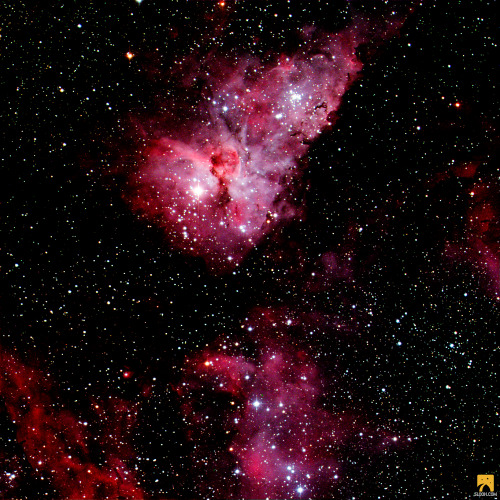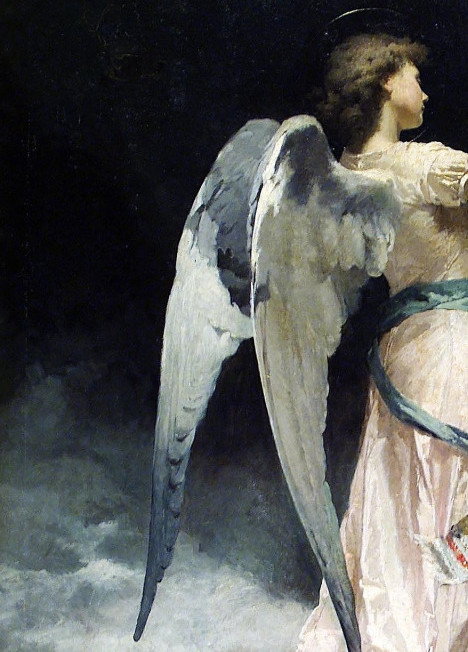Mystarypi - MystaryPi

More Posts from Mystarypi and Others

This is the Pelican Nebula! 🦢🦢🦢
The molecular cloud of dark dust on the left of this image separates this nebula from the nearby North America Nebula. This nebula is quickly changing as newborn, hot stars ionize the gas and push it around, leading to its expansion! 💖💖💖
Taken by me (Michelle Park) using the Slooh Canary Two telescope on August 9th, 2021 at 3:52 UTC.

This is the Eta Carinae Nebula! ✨✨✨
Due to its eruption in the 1840s, the mass of this stunning nebula has been challenging to measure. The colorful dust also dims the star’s ultraviolet and visible light by reradiating the shorter, more energetic light through longer wavelengths like infrared light! ❤❤❤
Taken by me (Michelle Park) using the Slooh Canary Two telescope on February 1st, 2022 at 5:32 UTC.

Mice of the Moon
The moon is made of cheesecake and I will not hear any arguments, these alien rodents prove it.

This is the Blue Moon! 🌝✨🌝✨🌝✨
A blue moon occurs when there are more than 1 full moon per month (it’s not actually blue 😭). We were lucky to have it on Halloween since this occurrence is pretty rare: the next time there will be a blue moon on Halloween is 19 years from now! 👻🎃🦇🍬🍭🍫
Taken by me (Michelle Park) using the Slooh Canary Two telescope on October 31st, 2020 at 23:29 UTC.

This is the Orion Nebula! ✨✨✨
There are around 700 newborn stars in this nebula and more are being born each year! This is without a doubt, the most photographed object in the night sky due to its bright and radiant colors. You might even be able to see it without a telescope (in good weather)! 😍😍😍
Taken by me (Michelle Park) using the Slooh Canary Two telescope on September 14th, 2020 at 5:36 UTC.

This is the Eskimo Nebula! ⛄⛄⛄
This nebula is created by the death of a Sun-like star and its strange 2 layered appearance gives it a lot of creative names such as the Clown-Faced Nebula or the Lion Nebula. Even though it looks like the planetary nebula is smooth, the reality is that it has dense filaments of matter all around it! ✨✨✨
Taken by me (Michelle Park) using the Slooh Chile One telescope on December 6th, 2020 at 3:58 UTC.

This is Haley’s Coronet! 👑👑👑
The interaction between the larger spiral galaxy and its dwarf galaxy have created plumes of dust around the duo. The process of the larger galaxy eating the smaller one is actually called galactic cannibalism (spooky)! 👻👻👻
Taken by me (Michelle Park) using the Slooh Chile Two telescope on January 13th, 2021 at 3:18 UTC.

Stardust In Aries

This is the Black Eye Galaxy! 🌌🌌🌌
The disk of this galaxy vigorously produces stars with its rapid inflow of mass into the incredibly active black hole at the center. An inner disk produces this galaxy’s distinct dust lane that gives it its name! 🌃🌃🌃
Taken by me (Michelle Park) using the Slooh Canary Two telescope on March 7th, 2021 at 4:53 UTC.

Gioacchino Pagliei (detail)
-
 lordy-lorde liked this · 8 months ago
lordy-lorde liked this · 8 months ago -
 forimnayeon reblogged this · 9 months ago
forimnayeon reblogged this · 9 months ago -
 neussi liked this · 1 year ago
neussi liked this · 1 year ago -
 pinkpandabanana liked this · 1 year ago
pinkpandabanana liked this · 1 year ago -
 hologramhoneymoon liked this · 1 year ago
hologramhoneymoon liked this · 1 year ago -
 burningituphere liked this · 1 year ago
burningituphere liked this · 1 year ago -
 easter-cakes228 liked this · 2 years ago
easter-cakes228 liked this · 2 years ago -
 kiwwitea liked this · 2 years ago
kiwwitea liked this · 2 years ago -
 alguien000blog liked this · 2 years ago
alguien000blog liked this · 2 years ago -
 creaturecleric liked this · 2 years ago
creaturecleric liked this · 2 years ago -
 monfolamour liked this · 2 years ago
monfolamour liked this · 2 years ago -
 twicenacao liked this · 2 years ago
twicenacao liked this · 2 years ago -
 mapis11-blog1 liked this · 2 years ago
mapis11-blog1 liked this · 2 years ago -
 sparkleswinx reblogged this · 2 years ago
sparkleswinx reblogged this · 2 years ago -
 tarte-au-beurre liked this · 2 years ago
tarte-au-beurre liked this · 2 years ago -
 bubbles-62 liked this · 2 years ago
bubbles-62 liked this · 2 years ago -
 sunmistails-blog reblogged this · 2 years ago
sunmistails-blog reblogged this · 2 years ago -
 sunmistails-blog liked this · 2 years ago
sunmistails-blog liked this · 2 years ago -
 complexuwu liked this · 2 years ago
complexuwu liked this · 2 years ago -
 ilysmjihyo reblogged this · 2 years ago
ilysmjihyo reblogged this · 2 years ago -
 ilysmjihyo liked this · 2 years ago
ilysmjihyo liked this · 2 years ago -
 northdawn liked this · 2 years ago
northdawn liked this · 2 years ago -
 tailsmelv025 reblogged this · 2 years ago
tailsmelv025 reblogged this · 2 years ago -
 tailsmelv025 liked this · 2 years ago
tailsmelv025 liked this · 2 years ago -
 rufflesiah liked this · 2 years ago
rufflesiah liked this · 2 years ago -
 phrogv3 liked this · 2 years ago
phrogv3 liked this · 2 years ago -
 tempressmac liked this · 2 years ago
tempressmac liked this · 2 years ago -
 catzhyo liked this · 2 years ago
catzhyo liked this · 2 years ago -
 raiwooo liked this · 2 years ago
raiwooo liked this · 2 years ago -
 avoidme101 liked this · 2 years ago
avoidme101 liked this · 2 years ago -
 lildewdrops reblogged this · 2 years ago
lildewdrops reblogged this · 2 years ago -
 justheretoseemyships reblogged this · 2 years ago
justheretoseemyships reblogged this · 2 years ago -
 tsukiara liked this · 2 years ago
tsukiara liked this · 2 years ago -
 the13thstar liked this · 2 years ago
the13thstar liked this · 2 years ago -
 mikipid liked this · 2 years ago
mikipid liked this · 2 years ago -
 cosmictakeover reblogged this · 2 years ago
cosmictakeover reblogged this · 2 years ago -
 cosmictakeover liked this · 2 years ago
cosmictakeover liked this · 2 years ago -
 archeryqueen95 liked this · 2 years ago
archeryqueen95 liked this · 2 years ago -
 jeongtinyy liked this · 2 years ago
jeongtinyy liked this · 2 years ago -
 atlantix123 liked this · 2 years ago
atlantix123 liked this · 2 years ago -
 huffiebear reblogged this · 2 years ago
huffiebear reblogged this · 2 years ago -
 lostcat420 reblogged this · 2 years ago
lostcat420 reblogged this · 2 years ago -
 okaymaybeiamabitobsessed liked this · 2 years ago
okaymaybeiamabitobsessed liked this · 2 years ago -
 rosiemissfandomchaos reblogged this · 2 years ago
rosiemissfandomchaos reblogged this · 2 years ago -
 lynher liked this · 2 years ago
lynher liked this · 2 years ago -
 bunnycuns liked this · 2 years ago
bunnycuns liked this · 2 years ago -
 gimmecards reblogged this · 2 years ago
gimmecards reblogged this · 2 years ago
